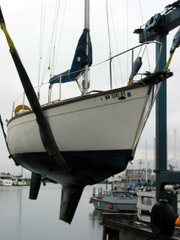Keels
A keel can mean either of two parts; a structural element, or a hydrodynamic element; these parts overlap.
Structural keels
A structural keel is a large beam which runs the of a ship is built around. The keel runs in the middle of the ship, from the bow to the stern, and serves as the or spine of the structure, providing the major source of structural strength of the hull. The keel is generally the first part of a ship's hull to be constructed, and laying the keel, or placing the keel in the cradle in which the ship will be built, is often a momentous event in a ship's construction--so much so that the event is often marked with a ceremony, and the term has entered the language as a phrase meaning the beginning of any significant undertaking.
Hydrodynamic keels
A hydrodynamic keel is a structure on the bottom of the hull that is used to give the vessel greater directional control and in many vessels contains a good portion of the balast. In traditional boatbuilding, this is provided by the structural keel, which projects from the bottom of the hull along most or all of its length. In sailing hulls, the keel helps the hull to move forward, rather than slipping to the side.
Sailboat Keels

Yacht with fin keel
In sailboats, keels use the forward motion of the boat to generate the force to counter the lateral force from the sails. Sailboats have much larger keels than non sailing hulls. Keels are different from centerboards and other types of foils in that keels also hold ballast to stabilize the vessel. Keels may be fixed, or non-moveable, or they may retract to allow sailing in shallower waters. Retracting keels may pivot (a swing keel) or slide upwards to retract, and are usually retracted with a winch due to the ballast. Since the keel provides far more stability when lowered than when retracted (due to the greater moment arm involved) the amount of sail carried is generally reduced when sailing with the keel retracted.
There are several types of fixed keels including: full keels, fin keels, winged keels, bulb keels, and twin keels or bilge keels among other designs.
Non-fixed keels are known as canting keels or Swing keels. These are found on racing yachts. They provide much more righting moment for a lot less weight, as the keel moves out to the windward-side of the vessel. The perpendicular distance from weight to pivot is increased, therefore a larger righting moment is produced.
Winged keel
A winged keel is a sailboat keel, usually of high aspect ratio, that uses a nearly horizontal foil, the "wing", at the bottom to provide additional performance. The horizontal foil serves two purposes: it acts as an winglet on the foil, effectively doubling the aspect ratio, and they produce additional lift, but downwards. Because the yacht is heeled over when sailing upwind the leeward foil is closer to vertical, and provides additional side force hence making the boat sail upwind more efficiently. The windward winglet is closer to horizontal and hence produces a force directly downward, which gives a small benefit to the vessel's stability. Winged keels are generally found on high performance sailboats, if they are not prohibited by class rules. They are only of benefit for yachts sailing upwind where stability and the ability to produce side force are important. Downwind the extra skin friction drag is a hindrance. The increased stability afforded by the winged keel, due mainly to the extra lead in the wings producing a very low centre of gravity. The wings were angled downwards at about 20 degrees, which, since they were lifting downwards, acted as a dihedral. Most winged keels also incorporate a significant amount of ballast where the wings join the keel. This feature makes these winged keels also a type of bulb keel.